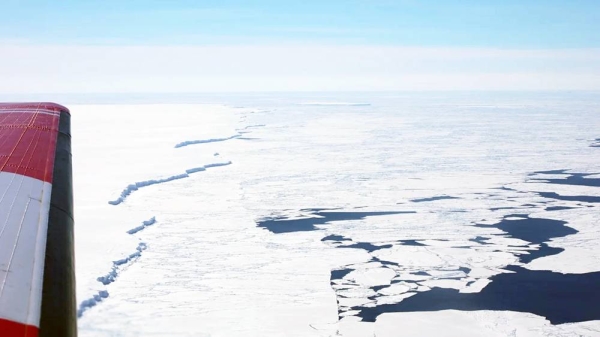
There are stadium-sized blocks of ice crashing from the soaring face of the Kangerlussuup glacier in western Greenland. Fierce underwater currents of meltwater are shooting out from its base and visibility below the surface is virtually zero thanks to a torrent of suspended mud and sand. It’s little wonder scientists have never explored this maelstrom.
Yet today, they are sending in a multimillion-dollar remotely operated submarine, potentially to its death. As the scientists onboard the Celtic Explorer research ship repeatedly say: “It’s a high risk, high reward mission.”
The reward is solving a mystery that could transform the understanding of the most profound long-term impact of the climate crisis: surging sea levels. Glaciers fed by ice caps are increasingly disintegrating, and how fast this will accelerate directly affects a billion people in the world’s great coastal cities.
However, current models do not take account of a big possible factor: the huge mounds of ground rock that some glaciers pile up in front of them, blocking their paths and insulating them from ever hotter oceans. These could function as “speed bumps”, effectively slowing the impact of global heating. But the role this plays is unknown because researchers had never been able to scrutinise the hellish zone where mighty glaciers, rock and ocean meet.
Now, they are. “Oh my God, what is that?” says Prof Ginny Catania, the expedition’s chief scientist, from the University of Texas (UT). She is looking at the screens in the tense control room on the ship. The live sonar feed from the submersible has revealed a vast underwater cavern in the glacier.
The engineer Victor Naklicki is piloting the sub, a feat of fierce concentration over the 10-hour dive. Afterwards, he says: “It was pretty crazy down there – we saw the big cave and you could feel the [sub’s] thrusters working very hard to not get sucked right in. We made it 50 metres into it, but it went even deeper – it was an abyss.”
The move inside went against all conventional piloting wisdom, he says, as putting a remotely operated sub under anything means it can’t float back to the surface if something goes wrong: “But the prize is collecting data that has never been collected before.”
The biggest of the prizes is taking core samples of the sediments piling up right at the glacier’s foot – no one has got closer than 500 metres before. But delicately manipulating the robot arm in zero visibility, while piloting the vehicle, is extraordinarily difficult. “It’s like you’re driving through a blizzard up in Buffalo, New York, while doing origami over in the back seat, as the car is moving around at 60 miles an hour,” Naklicki says.
The submersible, called Nereid Under Ice (NUI), has other close scrapes. A deluge of mud and sand dumped 25kg on the vehicle at one point, threatening to ground it. During another dive, an iceberg the size of 45 football pitches crashed off the glacier – without an unplanned launch delay, NUI could have been crushed. “We dodged a bullet,” says Rosemary Loer, another of the NUI team, from Woods Hole Oceanographic Institution (WHOI).
“But there’s no better feedback than when the scientists are standing behind you and they’re like: ‘Oh my God. This is crazy. We never expected this. This changes everything’,” says Naklicki.
The data from NUI is critical to solving the mystery of how sediment banks may slow glacier break-up. “Model projections for the future of Greenland are just all over the place,” says Catania. “Very rapid sea level rise has been documented in the past and so: is it possible to get that again? We are certainly perturbing the climate system enough.” Amid warnings of potential collapse of the Greenland ice sheet, which would push up sea levels by 7 metres, a better understanding of when the map of the world may be redrawn is vital.
Prof John Jaeger, from the University of Florida, leads the sediment experts onboard the expedition ship: “In Florida, we clearly see sea level rise already: coastal cities there are already getting flooded out on high tides. A lot of the forecasting models are not taking into account what we’re looking at here, which is the speed bump to the ice retreating. If we begin to melt a lot of ice, and [a glacier] begins to move very quickly, it can actually create a lot of sediment, and maybe that is a feedback mechanism that will slow it down.”
Fully understanding this process requires a swathe of scientific expertise and the ship is a floating laboratory – with a spectacular view. Two-thousand-metre mountains tower over the remote fjord, with tributary glaciers snaking their way down to the ice strewn water, all glittering in the 24-hour sunlight. Thunderous rumbles roll through the cold air as giant icebergs calve, while fizzes and pops come from the melting ice as ancient bubbles of air are liberated.
The focus is the colossal glacier at the end of the 50km-long fjord. Its ragged face is 5km wide and 300 metres tall, much of it hidden below the surface. While beyond the ship there is a savage serenity to the fjord, onboard there is a buzz of activity day and night, with every moment in this remote place too valuable to waste.
NUI is the focus of the day shift, led by Molly Curran from WHOI, and is lowered into the water with the care of placing a baby in a cot. But then it ventures off into the violent world of the glacier’s terminus, connected only by a hair-thin fibre-optic cable, kilometres long, which allows it to roam to places other remotely operated vehicles cannot.
Curran’s colleague Mike Jakuba says wryly: “If we lose the vehicle, that would be a lot of paperwork. But the pressure is not about the vehicle – it’s about delivering for the scientists.” NUI is packed with kit doing just that: scanning the glacier face and sediment banks in high resolution, measuring the velocity, temperature and saltiness of the water and grabbing those crucial samples.
Jaeger, celebrating the 30th anniversary of his first Arctic expedition, says: “I could never get closer [to the glacier’s terminus] than about a kilometre because of safety reasons. That gap was always frustrating. Now NUI gives us the chance to get in there and collect these amazing datasets.”
On the day shift, drones repeatedly map the ever-changing shape of the glacier from the air – it moves 5 metres a day – building up an extraordinary 3D picture of its face. One major goal for the drone is to spot where cloudy, sediment-laden plumes are gushing out of the glacier. “Sometimes it looks like a boiling pot,” says the engineering scientist Marcy Davis from UT.
At night, the glacier and fjord are probed in different ways. Multiple seismic surveys, including the “chirping” that regularly echoes around the ship, sees through the seafloor to the layers beneath. These will reveal how the sediment banks have been built in the past, and the best places to sample long cores.
This requires dropping a 6-metre weighted tube straight down into the seabed like a torpedo. The silky clay-rich mud brought back feels like an expensive face mask, but it enables the researchers to go back in time. “That’s probably about 20 years of sediment,” Jaeger says, examining faint annual layers in a 2-metre-long sample.
The oceanographer Bridget Ovall from Rutgers University says the team are inventing new strategies on the fly to measure the speed of the underwater currents: “We’re having to make it up as we go along, as no one has done this before.”
As the first measurements came in, Catania says: “I cried a little bit, because it was really exciting to see, and finally the drudgery of planning this for years was paying off.” The expedition had been a decade in the making, drumming up funding for such a high risk project, then getting the scientists and all their kit into the Arctic Circle and then finding the right fjords not blocked by minefields of ice.
The incredibly high-resolution data gathered by NUI is unique, she says: “It was like putting glasses on for the first time, when you can suddenly see all the leaves in the trees. The detail is striking, like seabed channels that we’ve never seen before – that we didn’t know even existed.”
“Now the fun starts, to try to interpret it all, understanding what the heck it is that we’re even looking at,” Catania says. “The observations are so novel that even the ways that we process the data have to be changed.” That will take time but the implications of the work in this inhospitable corner of Greenland could reverberate across every country with a coastline. “I’m hoping it will make a big impact in terms of understanding,” she says.
“We know that in these systems, there are tipping points,” says Prof Sean Gulick, the expeditions’ co-chief scientist. “But if a glacier creates a large pile of sediment, it might delay some of the catastrophic retreat that people are most worried about. These glaciers in west Greenland are particularly important because they’re fed directly from the Greenland ice sheet.”
“They are the frontline of the battle between the [warming] ocean and the ice,” he says. Other recent research has shown Greenland’s ice sheet vanished in the past when global temperatures were similar to those today.
Not all glaciers build giant sediment banks, but knowing whether this affects the biggest and most dangerous glaciers in Greenland and Antarctica will be critical information, says Catania. That is because sea level rise does not happen evenly around the world. “So if we can say where this sedimentation process is more important, that might help us to understand what cities are going to be more at risk from the collapse of ice sheets,” she says.
“On the Texas coast, a lot of people live in houses on stilts, because of hurricanes,” she says. “If you’re building you want to know, do you need to build it 4 metres high or 8 metres high?”
The research could even inform a geoengineering idea. “One proposal has been to try to shore up our glaciers and ice sheets against the impact of warming ocean water, by building barriers,” says Benjamin Keisling, an ice modeller at UT.
“Of course, that represents a massive undertaking, logistically and financially, but the ocean is taking up more and more heat as the atmosphere warms,” he says. “Building a barrier like that seems absurd, but then you realise that’s actually something that nature does naturally.”
The sediment banks may prove to be a helpful delayer of sea level rise in places, giving communities a little more time to prepare. But substantial rises are already unavoidable, warns Catania. “We really need to plan for the inundation at the coastlines, because it’s coming. We don’t know when, and certainly we need to answer that question, but we have little planning at many coastlines, especially in the many countries that are not wealthy, that are going to get completely inundated.”
The scientists onboard the Celtic Explorer are dedicated to answering these crucial climate questions, and aware of the stakes for humanity. But there is also space aboard for personal reflection as the expedition ends successfully, with a host of brand new data.
NUI’s pilot, Naklicki, uses a modified Xbox gaming controller to fly the submersible. “Growing up, I played a lot more video games than my parents would have liked. But there’s some good pictures of me on this cruise using that controller. I wish I could take that picture back in time and show my parents when they told me to stop playing games and do my homework. It paid off eventually.”
Catania is also thinking of family: “This is the longest I’ve been away from my kids. My husband passed when I was supposed to come here in 2013 and so I didn’t come – my kids were two at the time. So me being able to come here is a big coup. The logistics for this cruise was one thing, but I also had to plan the logistics for leaving my children with family and friends and stuff for the last month as well. It’s really going to be nice to be home.”












